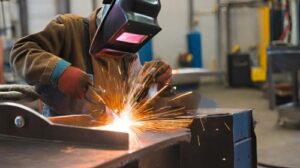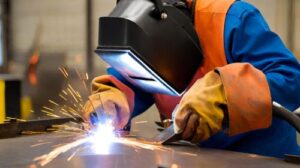Table of Contents
When the term welding comes up, images of intense heat, sparks flying, and metal manipulation might dominate the imagination. It’s often perceived as a job that demands Herculean strength and advanced technical knowledge. But is welding truly a hard job, or does it bear a different reality behind the flashy exterior?
Defining Welding
At its most basic, welding involves the application of heat to melt and fuse metals, creating a strong bond. This process is integral to constructing bridges, skyscrapers, pipelines, and even intricate components in electronic devices. Welding isn’t merely about merging metals; it’s a precise technique demanding a deep understanding of materials, heat, and structural integrity.
Addressing Perceptions about Welding
Perceptions about welding often revolve around the idea of a labor-intensive job requiring brute strength. The imagery of sparks flying, intense heat, and the physical demands can overshadow the intricate skill set and technical knowledge that welding truly demands.
However, these perceptions often fail to acknowledge the finesse and expertise required in welding. It’s not just about wielding a torch; it’s about mastering the art of manipulating metal to form strong, durable bonds that can withstand immense pressures and stresses.
The purpose of this exploration is to delve beyond the stereotypes and uncover the multifaceted nature of welding. From its various processes to the skills demanded, this article aims to shed light on whether welding truly lives up to its reputation as a difficult job or holds a different reality beneath the surface.
Understanding welding as both a craft and a crucial industrial process is key to appreciating its complexity and the skills wielded by those who excel in this field.
Understanding the Complexity of Welding
Welding is a multifaceted field, encompassing various processes, each with its unique requirements and intricacies. These processes, including stick welding, MIG (Metal Inert Gas), TIG (Tungsten Inert Gas), and more, demand specialized skills and expertise.
Different types of welding techniques cater to distinct purposes. For instance, stick welding, also known as Shielded Metal Arc Welding (SMAW), is one of the oldest and most versatile methods, suitable for welding various materials in different positions. On the other hand, TIG welding involves using a non-consumable tungsten electrode to create precise and clean welds, ideal for thinner metals and intricate joints.
Skills Required for Welding
Mastering welding techniques isn’t just about manipulating a welding torch. It involves a comprehensive understanding of metallurgy, the behavior of different metals under heat and pressure, and the ability to interpret complex blueprints and welding symbols.
Moreover, precision and attention to detail are paramount. Welders must maintain a steady hand and focus to ensure accurate welds that meet strict structural requirements and safety standards.
Challenges Faced in Welding
The challenges in welding extend beyond technical proficiency. Welders often work in physically demanding conditions, enduring extreme temperatures, cramped spaces, and awkward positions for extended periods. This demands not just physical endurance but also mental resilience.
Moreover, welding involves working with potentially hazardous materials and equipment. Welders must adhere to stringent safety protocols to protect themselves and others from risks like fumes, radiation, and electrical hazards.
In essence, the complexity of welding isn’t merely in the act of joining metals; it’s in the amalgamation of technical expertise, physical endurance, and meticulous attention to detail required to produce high-quality welds that meet stringent industry standards. Understanding these intricacies is crucial to appreciating the skill and dedication that welders bring to their craft.
Factors Contributing to the Perception of Difficulty
The perception of welding as a challenging job stems from various factors that contribute to its perceived difficulty. These factors encompass physical demands, technical knowledge requirements, and considerations of the work environment.
Physical Demands of Welding
Welding involves physically demanding tasks. Welders often work in confined spaces, assuming uncomfortable positions for prolonged periods to access and weld components in complex structures. Additionally, the exposure to extreme temperatures generated during welding processes adds to the physical strain. The combination of heat, uncomfortable postures, and repetitive motions can take a toll on the body, demanding resilience and endurance from welders.
Technical Knowledge and Expertise Needed
Beyond the physical aspects, welding demands a depth of technical knowledge and expertise. Understanding welding techniques, materials, and equipment is crucial. Interpretation of intricate blueprints, weld symbols, and specifications requires precision and attention to detail. Calculations related to materials’ thermal properties and structural integrity are integral to producing quality welds.
Work Environment Considerations
The work environment in welding can also contribute to its perceived difficulty. Often, welders operate in challenging conditions, including noisy environments, exposure to fumes, and hazardous materials. Adherence to strict safety protocols is imperative, adding an additional layer of complexity to the job.
Navigating these factors requires a blend of physical resilience, technical proficiency, and a keen understanding of safety measures. The amalgamation of these elements contributes to the perception of welding as a challenging and demanding profession. However, delving deeper into the realities of welding unveils a more nuanced picture beyond these initial challenges.
Realities Behind Welding
Despite the perceived challenges, the field of welding presents a range of opportunities and realities that paint a more comprehensive picture of this profession.
Training and Education Available
There’s a plethora of training programs and educational avenues tailored for aspiring welders. Vocational schools, community colleges, and specialized welding institutes offer comprehensive courses covering various welding techniques, metallurgy, blueprint reading, and safety protocols. These programs equip individuals with the necessary skills and certifications to enter the workforce as competent welders.
Advancements in Technology Aiding Welding
Technology has significantly transformed the welding landscape. Automated systems and robotic welding have revolutionized the industry, enhancing precision and efficiency while reducing the physical strain on welders. These advancements have not only improved the quality of welds but have also opened new avenues for specialization and innovation within the field.
Personal Experiences of Welders
The stories of seasoned welders often highlight the initial challenges but also emphasize the gratification and sense of accomplishment associated with mastering this craft. Many welders recount their journeys from novices to skilled professionals, citing the satisfaction derived from creating robust structures or intricate components through their expertise.
These realities showcase that while welding does have its challenges, there exist numerous pathways for individuals to acquire skills, leverage technology, and find fulfillment in a career that goes beyond the initial perception of difficulty. The fusion of training opportunities, technological advancements, and personal experiences reshapes the narrative around welding, offering a more optimistic outlook for aspiring welders.
Debunking Misconceptions about Welding
Contrary to prevailing misconceptions, welding is not merely a physically demanding job but a profession that encompasses creativity, skill, and opportunity. It’s time to shed light on the realities that challenge these misconceptions and redefine the perception of welding.
Highlighting Successful Stories in Welding
Numerous success stories in welding stand as testament to the potential and opportunities within the field. Individuals who started with limited knowledge and experience but pursued welding as a career have achieved remarkable feats. These stories often emphasize the transformative power of dedication, perseverance, and the right training in building a successful career in welding.
Changing Perspectives on Welding as a Career
The traditional view of welding as solely a manual labor-intensive job is evolving. Industries are recognizing the value of skilled welders not just for their ability to fuse metals but for their problem-solving skills, adaptability, and precision. The narrative is shifting from viewing welding as a mere trade skill to acknowledging it as a specialized profession requiring technical expertise and creativity.
By highlighting the success stories and shifting perceptions, the aim is to challenge the misconceptions surrounding welding. It’s about showcasing that welding isn’t confined to stereotypes but is a dynamic and rewarding career choice with ample opportunities for growth and innovation.
Is Welding a Challenging Job or a Fulfilling Career?
Determining whether welding is solely a challenging job or a fulfilling career involves weighing various aspects that define the profession.
Balancing the Difficulties with Rewards
Welding undoubtedly presents its challenges, from physical demands to the need for technical expertise. The work can be physically taxing, requiring endurance and resilience. Moreover, the continuous need to adapt to various conditions and projects demands a high level of skill and adaptability.
However, these challenges are often balanced by the rewards that welding offers. The satisfaction derived from creating something tangible, whether it’s a structural component or an intricate piece of machinery, adds a sense of accomplishment. Seeing the results of precision and skill manifest in a completed weld often serves as a source of pride for welders.
Job Prospects and Opportunities in Welding
Welding offers a wide array of job prospects across diverse industries. From construction and manufacturing to automotive and aerospace, skilled welders are in demand. Additionally, as industries evolve and technology advances, the role of welders becomes increasingly crucial in innovating and implementing new techniques and methodologies.
The blend of technical prowess, creativity, and hands-on work makes welding a promising career choice for many. The challenges are intrinsic, but they often pave the way for personal and professional growth, making welding not just a job but a fulfilling and rewarding career path for those passionate about the craft.
Conclusion
In conclusion, welding, often misconstrued as a tough job, reveals itself as a profession teeming with challenges and opportunities. Beyond the initial perceptions of heat and labor lies a craft demanding skill, resilience, and innovation. Despite its complexities, welding offers a fulfilling career path, blending technical expertise with creativity and hands-on work. It’s a field where dedication paves the way for personal growth, making it not just a job but a rewarding journey into the art and science of metal fusion.
Is welding a secure career choice?
Welding offers stable job prospects across multiple industries, making it a viable career choice.
Do you need a college degree to become a welder?
While formal education can be beneficial, vocational training and certifications are often sufficient to kickstart a welding career.
Is welding only about manual labor?
No, it involves a blend of technical knowledge, creativity, and precision alongside manual work.
Are advancements in technology affecting welding jobs?
Technology advancements in welding have led to new opportunities and improved safety measures.
Can anyone become a welder?
With dedication and proper training, anyone interested in welding can pursue it as a career.





2 thoughts on “Is Welding a Hard Job?”